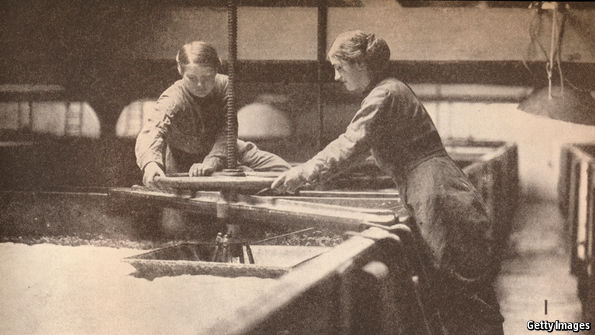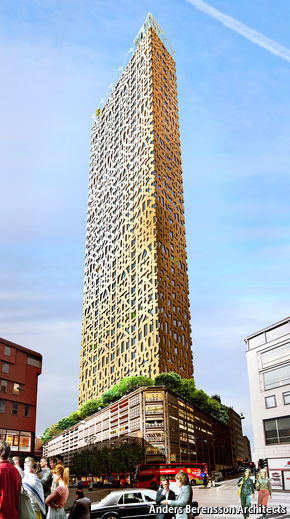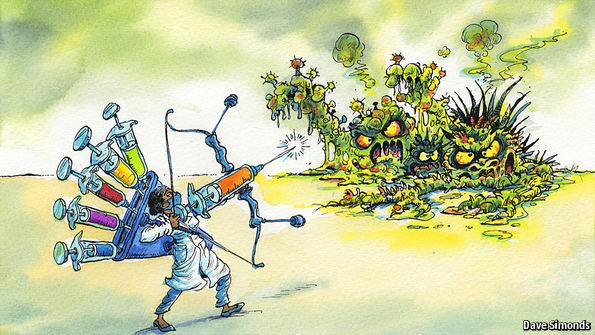Undermining infection
Source: Economist

CATTLE ranchers know that if they want to increase their yields it is best to breed their largest cows with their biggest bulls. The same idea works when trying to improve other livestock, crops and pets. Although less well known, microorganisms can also be bred selectively. Given that yeasts have a long history of being used to ferment food and drink, archaeologists have argued for years that early craftsmen may have selectively bred yeast strains without even realising it.
Now there is evidence to support this idea. Steven Maere of the University of Ghent and Kevin Verstrepen of the University of Leuven, both in Belgium, and their colleagues have been studying the genomes of culinary yeast species. As they report in Cell this week, the researchers have found evidence that people started domesticating yeast strains, particularly those used in beer, some 500 years ago.
Today’s bakers, vintners and brewers have intimate knowledge of yeasts and choose strains that improve their products and grant specific flavours. But until the work of Louis Pasteur in the mid-19th century nobody knew that microorganisms existed. However, a process called…Continue reading
Source: Economist

THE five-storey pagoda of the Temple of the Flourishing Law in the Nara prefecture of Japan is one of the world’s oldest wooden buildings. It has withstood wind, rain, fire and earthquakes for 1,400 years. Analysis of the rings in the central pillar supporting the 32-metre structure suggests the wood that it is made from was felled in 594, and construction is thought to have taken place soon after.
In an age of steel and concrete, the pagoda is a reminder of wood’s long history as a construction material. New techniques mean that wood can now be used for much taller buildings. A handful are already going up in cities around the world. The 14-storey Treet block of flats in Bergen, Norway, is currently the tallest. But Brock Commons, an 18-storey wooden dormitory at the University of British Columbia in Canada, is due to be completed in 2017. That is when construction is expected to begin on the 21-storey Haut building in Amsterdam. Arup, a firm of engineering consultants working on the project, says it will be built using sustainable European pine. Some architects have even started designing wooden skyscrapers, like the proposed Tratoppen…Continue reading
Source: Economist

PARENTS are not the only ones bemoaning the way so many schools have given up teaching children to write longhand. Researchers are also aware that more than mere pride in penmanship is lost when people can no longer even read, let alone write, cursive script. Not being able to exchange notes with the boss or authenticate signatures, for instance, can hurt a person’s chances of promotion. More importantly—and intriguingly—though, learning to join letters up in a continuous flow across the page improves a child’s ability to retain and understand concepts and inferences in a way that printing those letters (and, a fortiori, typing them on a keyboard) does not. It even allows insights gained in one learning experience to be applied to wholly different situations.
Neurophysiologists in Norway and France, for example, have found that different parts of the brain are stimulated when reading letters learned by writing them on paper, rather than by typing them on a keyboard. The movement and tactile response involved in handwriting leaves a memory trace in the sensorimotor part of the brain, which are retrieved when reading the letters involved. Being essentially the…Continue reading
Source: Economist

TINY electronic devices known as a “lab-on-a-chip” are now routinely used to analyse small biological samples, sometimes a few microlitres or less, and to carry out out other tasks such as purifying proteins and DNA. Some even reproduce the functions of a complete organ, like a kidney or lung, so that they can be used to test drugs reliably and cheaply.
Many of these devices, though, end up not so little because of the bulky ancillary parts and chunky bits of tubing required to pump fluids in and out of the chips. This can limit their application. What would be good is a way to make the complete system more portable—or, indeed, wearable so that the devices can be used to test patients regularly. That means shrinking the external paraphernalia down to a size more comparable to the chip itself.
Yanlei Yu at Fudan University in Shanghai and her colleagues think they have found a way to do that. They used fine tubes (pictured) made from a new material that allows small quantities of fluid to be moved around precisely simply by aiming a beam of light at them—in effect creating tiny, light-activated pumps (see video below).
Dr Yu turned to liquid-crystal…Continue reading
Source: Economist

“IN THIS style, $400,000.” That price tag for a hat sounds like something out of a tea party attended by Alice. It is actually, though, the expected cost of the world’s most high-tech helmet—one to be worn by pilots of the Lockheed Martin Lightning II, also known as the F-35, which has been developed by America and its allies to replace most of their existing strike aircraft. In the context of a plane costing between $148m and $337m, depending on exactly which model you order, the price of the helmet is, perhaps, trivial. But for that amount you might expect to get something pilots are universally happy with. And they are not.
The helmet is a wonder. Fighter pilots have long been used to a “heads-up” display—an image of cockpit data and targeting information displayed on the windscreen in front them. The F-35 helmet goes much further. Not only does it display that detail, and much else besides, on the helmet’s visor but it also takes video images from six external cameras mounted around the aircraft and shows that as well. This allows the pilot to “look-through” the aircraft at any angle. Want to see what is happening below? Then look down and instead of your…Continue reading
Source: Economist
 The answer lies in the soil
The answer lies in the soilCHRONIC-FATIGUE SYNDROME, or CFS, which afflicts over 1m people in America and 250,000 in Britain, is certainly chronic and surely fatiguing. But is it truly a syndrome, a set of symptoms reliably associated together and thought to have a single underlying cause—in other words, a definable disease?
CFS’s symptoms—debilitating exhaustion often accompanied by pain, muscle weakness, sleep problems, “brain fog” and depression—overlap with those of other conditions. These include fibromyalgia (itself the subject of existential doubt), clinical depression, insomnia and other sleep disorders, anaemia and diabetes. These overlaps lead some to be sceptical about CFS’s syndromic nature. They also mean many people with CFS spend years on an expensive “diagnostic odyssey” to try to find out what is going on.
Scepticism about CFS’s true nature is reinforced by the number of causes proposed for it. Viruses, bacteria, fungi and other types of parasite have all had the finger pointed at them. So have various chemicals and physical trauma. Evidence that CFS truly does deserve all three…Continue reading
Source: Economist

FOREWARNED, the proverb has it, is forearmed. But what happens when there is no warning? That was the case in December 2013, when an outbreak of Ebola haemorrhagic fever began in Guinea. It spread rapidly to Liberia and Sierra Leone and raged on for over a year. Around 29,000 people were infected. More than 11,000 of them died.
The world responded to this crisis, shipping in doctors, nurses and medical equipment. But what it could not ship in, for none existed, was the thing that would most quickly have stopped the epidemic: a vaccine. Such a vaccine was created eventually, but by the time it was ready, the outbreak was all but over. Had it been available from the beginning, things could have been different.
Next time, though, they might be, for on August 31st a new organisation came into being. CEPI, the Coalition for Epidemic Preparedness Innovations, was founded this week in London, at the headquarters of the Wellcome Trust, a medical charity. It is the joint brainchild of the Wellcome, the Bill and Melinda Gates Foundation, the World Economic Forum and the government of Norway, and its purpose is precisely to forearm the world against…Continue reading
Source: Economist

IF A room is cold, you have a choice. Pull on a jumper or a jacket, or turn up the heating. If it is hot, the obverse choice is not so easy to make. There is a limit to how much disrobing is permissible, and even the wearing of light garments such as T-shirts, in order to stay cool, is frowned on in some business circles. The default is therefore to switch on the air conditioning.
That may change if a discovery published this week in Science comes to commercial fruition. Yi Cui and his colleagues at Stanford University have discovered a fabric that keeps skin 2°C cooler than a cotton T-shirt. In terms of comfort, this is a significant drop—and one which would be good not only for the wearer but also for energy bills. If widely adopted it would mean buildings could be kept warmer than at present, saving huge amounts of electricity in the summer months.
Dr Cui’s goal was to cool the wearers of clothing by tinkering with the way heat radiates from their bodies. More than half of body heat is in the infrared (IR) part of the spectrum. This means its wavelength is longer than that of visible light. Materials like…Continue reading
Source: Economist